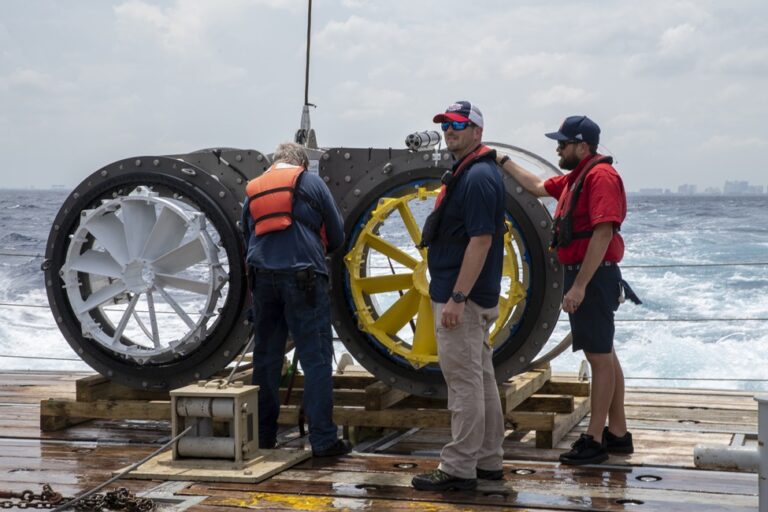Florida Atlantic University to test feasibility of grid-connected ocean energy facility
October 31, 2024
Florida Atlantic University’s (FAU) Southeast National Marine Renewable Energy Center (SNMREC) is set to evaluate the feasibility of a grid-connected offshore test facility in the Florida Current to determine how ocean energy technologies can be safely and economically integrated into the energy grid.

In collaboration with partners including the City of Lake Worth Beach Electric Utility, 3U Technologies, 48 North Solutions, IDOM Incorporated, Braid Theory, and the European Marine Energy Centre (EMEC), SNMREC will lead a feasibility study to assess the viability of a new ocean current test facility in the Gulf Stream off Palm Beach County.
According to FAU, if the study proves feasible, the project will lay the foundation for a blue energy hub in the region, marking a significant step forward in renewable energy tech.
“The Southeast National Marine Renewable Energy’s vision for a blue energy hub in Southeast Florida represents a significant step forward in renewable energy technology,” said Gregg Fields, FAU Vice President for Research. “By establishing a dedicated test facility, we hope to pave the way for a future where ocean currents become a key player in our clean energy landscape. With our strong marine energy industry connections and the expertise of our partners, the region is poised to become a global leader in ocean current energy innovation.”
With the $800,000 backing from the U.S. Department of Energy’s (DOE’s) Water Power Technologies Office (WPTO), the project aims to strengthen the U.S. marine energy sector by enhancing competitiveness, supporting domestic manufacturing, and generating job opportunities. SNMREC’s development strategy includes building a regional “blue energy cluster” in Southeast Florida to address all phases of utility-scale ocean current energy projects, such as turbine development, undersea cable deployment, and marine services.
According to FAU, currently, no operational ocean current test facilities exist worldwide.
“Southeast Florida is ideal for ocean current energy projects not only because of its favorable ocean current conditions but also due to several supportive socio-economic factors,” said Gabriel Alsenas, Principal Investigator and Director of SNMREC at FAU Harbor Branch Oceanographic Institute.
“Major ports, such as the Port of Palm Beach and Port Everglades, straddle SNMREC’s proposed test site offshore Palm Beach County to provide excellent access. Local utilities such as the City of Lake Worth Beach’s municipal utility and Florida Power & Light offer essential grid connections and support for a clean energy transition. Additionally, SNMREC has a strong network and extensive experience assisting current energy conversion technologies developers at various stages, further enhancing the region’s attractiveness for these projects.”
The facility aims to streamline marine energy technology integration and facilitate clean energy adoption on a larger scale. FAU stated that the feasibility study will focus on establishing grid integration for predictable and scalable marine power solutions by leveraging the Florida Current’s consistent flow.
“Before any marine energy project can succeed, it’s crucial to ensure that all aspects of the project can be integrated safely and economically at full scale, which is only possible with a dedicated offshore test facility connected to the grid,” Alsenas added. “Testing prototypes in real-world conditions helps refine technology, confirm performance, and reduce technical and financial risks before projects can be scaled for widespread use.”
FAU’s SNMREC will lead project management, deliverables, and risk assessments. Technical execution will include 3U Technologies providing submarine system specifications, IDOM overseeing shoreside facility requirements, 48N developing a regulatory framework, and Braid Theory conducting an economic impact analysis, FAU noted. EMEC will offer operational insights based on similar marine energy facilities, including PacWave.
“A cutting-edge South Florida offshore test facility will serve as a critical proving ground for technologies designed to generate electricity from ocean currents,” said James Sullivan, Executive Director, of FAU Harbor Branch. “But it’s not just about testing turbines. The project aims to address all aspects of developing large-scale ocean current energy projects – including the marine environment, increasing our understanding of our region’s coastal habitats.”
In March 2022, FAU revealed its plans to expand SNMREC with new university partnerships, capabilities, and opportunities.
Search
RECENT PRESS RELEASES
Related Post




